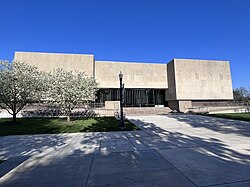West Virginia State Museum
 | |
 | |
Former name | West Virginia Science and Culture Center |
|---|---|
| Established | 1890 |
| Location | West Virginia Capitol Complex, 1900 Kanawha Blvd. East, Charleston, Kanawha County, West Virginia, United States[1] |
| Coordinates | 38°20′16″N 81°36′51″W / 38.3379°N 81.6141°W |
| Type | History museum, Art museum, Natural history museum |
| Owner | West Virginia Department of Arts, Culture and History, State of West Virginia |
| Website | wvstatemuseumed |
The West Virginia State Museum, formerly the West Virginia Science and Culture Center, is a history, culture, art, paleontology, archaeology and geology museum at the West Virginia Capitol Complex in Charleston, West Virginia.[2][3] It was founded in 1890 and is considered a major museum in the state by The Statesman's Yearbook.[4][5]
About
[edit]The museum is managed by the West Virginia Department of Arts, Culture and History and is located within the West Virginia Capitol Complex. Exhibits cover the state's natural history, cultural history,[6] art,[7] geology and coal, paleontology,[8] and historical settlements.
The museum collections are diverse and include a flag collection from the Confederate States Army;[9] a set of early medical tools from West Virginia's pioneering physician Joseph Robins;[10][6] and examples of Homer Laughlin China Company (now known as the Fiesta Tableware Company) Fiesta Tableware, a Newell-based ceramics manufacturer.[11] It also houses the Wilson Stone (also known as Braxton County Rune Stone and Braxton County Tablet), a piece of sandstone with carved inscriptions found in 1931 and with unknown origins.[12] In 1940, the state purchased the Wilson Stone and sent it to the University of Michigan archeologist Emerson F. Greenman, who concluded that it was, in all likelihood, a fraud.[12][13][14]
History
[edit]The earliest history of the museum started with the West Virginia Historical and Antiquarian Society in 1890, as an established exhibit in the state capitol.[15] West Virginia governor William McCorkle opened the museum in 1894 and it moved to a capitol annex, followed by a move to the capitol basement. In 1976, the collection was re-housed in the new West Virginia Science and Culture Center and featured state of the art exhibitions of history and culture in a chronological ordered display.[16][17] The West Virginia State Museum was awarded a grant (via Save America's Treasures) in 2001 for the creation of the "Civil War Regimental Flag Collection," in which many flags date as far back as 1890.[18][19] In summer 2009, a newly renovated museum building debuted, after being closed for five years for a US $17.9 million dollar remodel.[15][20]
In 2011, the United Mine Workers of America (UMWA) labor union's president Cecil Roberts wrote a detailed letter of complaint about issues of inaccurate depictions of their organization in the museum, as well as issues of inaccurate history, particularly around the Battle of Blair Mountain a violent labor dispute.[21]
Publications
[edit]- Catalogue of Exhibits in the State Museum (catalogue). West Virginia State Museum. Jarrett Printing Company. 1937.
{{cite book}}: CS1 maint: others (link)
See also
[edit]- Goldenseal (magazine), West Virginian quarterly magazine
- Kanawha Madonna
- List of museums in West Virginia
 Media related to West Virginia State Museum at Wikimedia Commons
Media related to West Virginia State Museum at Wikimedia Commons
References
[edit]- ^ Wesson, Cameron B. (2004-10-19). Historical Dictionary of Early North America. Scarecrow Press. p. 228. ISBN 978-0-8108-6551-8.
- ^ "West Virginia Culture Center and State Museum". Almost Heaven - West Virginia.
- ^ Geographic, National; Yogerst, Joe (September 4, 2019). 50 States, 5,000 Ideas: Where to Go, When to Go, What to See, What to Do. National Geographic Books. ISBN 978-1-4262-2120-0 – via Google Books.
- ^ Turner, B. (2016-12-29). The Statesman's Yearbook 2001: The Politics, Cultures and Economies of the World. Springer. p. 1853. ISBN 978-0-230-27129-6.
- ^ Turner, B. (2016-12-29). The Statesman's Yearbook 2002: The Politics, Cultures and Economies of the World. Springer. p. 1918. ISBN 978-0-230-27130-2.
- ^ a b Renfrew, Barry (1980-04-21). "Hacksaws, kitchen knives used in frontier medicine". Pacific Daily News. p. 21. Retrieved 2023-02-25.
- ^ Russell, John J.; Spencer, Thomas S. (2000). Art Across America: A Comprehensive Guide to American Art Museums and Exhibition Galleries. Friar's Lantern. p. 843. ISBN 978-0-9667144-1-8.
- ^ Petreycik, Rick; Boehme, Gerry (2016-07-15). West Virginia: Third Edition. Cavendish Square Publishing, LLC. p. 15. ISBN 978-1-62713-258-9.
- ^ "Flag Collection Traces History of Confederacy". The Gettysburg Times. 1938-12-19. p. 3. Retrieved 2023-02-25.
- ^ "Museum works to restore world of pioneer medicine". Times-Advocate. 1980-04-27. p. 8. Retrieved 2023-02-25.
- ^ Koplos, Janet; Metcalf, Bruce (2010-07-31). Makers: A History of American Studio Craft. University of North Carolina Press. p. 163. ISBN 978-0-8078-9583-2.
- ^ a b Michaels, Denver (2020-09-11). Giants: Men of Renown (in Brazilian Portuguese). SCB Distributors. p. 336. ISBN 978-1-948803-29-8.
- ^ "April 10, 1931: Braxton County Rune Stone Found". West Virginia Public Broadcasting. 2019-04-10. Retrieved 2023-02-25.
- ^ "Braxton County Rune Stone". e-WV: The West Virginia Encyclopedia. January 7, 2011. Retrieved 2023-02-25.
- ^ a b Wallace, Jim (August 14, 2012). A History of the West Virginia Capitol: The House of State. Arcadia Publishing. ISBN 9781614238171 – via Google Books.
- ^ "State Science-Culture Center to Open Sunday". The Weirton Daily Times. 1976-07-10. p. 5. Retrieved 2023-02-25.
- ^ "WV State Museum". West Virginia Department of Arts, Culture & History.
- ^ "Congressional Record - House" (PDF). US Congress. October 11, 2001.
- ^ "Much History Hangs Behind W.Va.'s Flags". The Intelligencer. Retrieved 2023-02-25.
- ^ Clauson-Wicker, Su (2022-06-01). West Virginia Off the Beaten Path®: Discover Your Fun. Rowman & Littlefield. p. 134. ISBN 978-1-4930-6580-6.
- ^ Harris, Wess; Kline, Michael (2017-10-01). "Cecil Roberts Shares His Story". Written in Blood: Courage and Corruption in the Appalachian War of Extraction. PM Press. pp. 138–. ISBN 978-1-62963-453-1.
